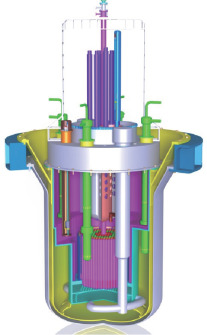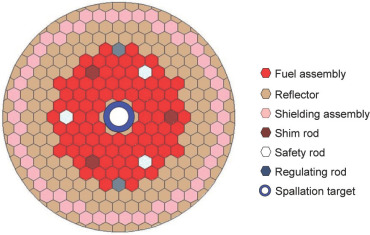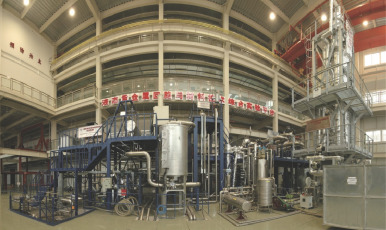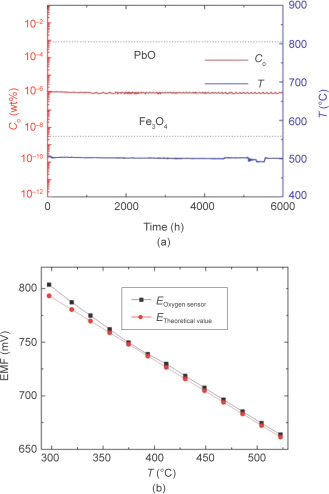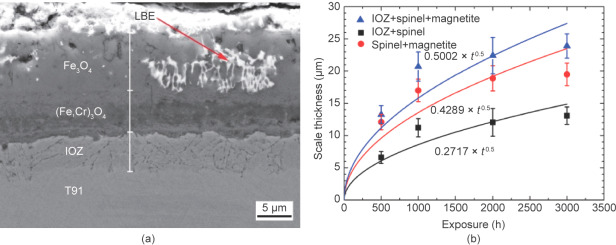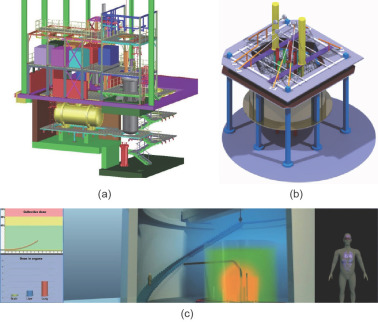ABSTRACT
In 2011, the Chinese Academy of Sciences launched an engineering project to develop an accelerator-driven subcritical system (ADS) for nuclear waste transmutation. The China Lead-based Reactor (CLEAR), proposed by the Institute of Nuclear Energy Safety Technology, was selected as the reference reactor for ADS development, as well as for the technology development of the Generation IV lead-cooled fast reactor. The conceptual design of CLEAR-I with 10 MW thermal power has been completed. KYLIN series lead-bismuth eutectic experimental loops have been constructed to investigate the technologies of the coolant, key components, structural materials, fuel assembly, operation, and control. In order to validate and test the key components and integrated operating technology of the lead-based reactor, the lead alloy-cooled non-nuclear reactor CLEAR-S, the lead-based zero-power nuclear reactor CLEAR-0, and the lead-based virtual reactor CLEAR-V are under realization.
Keywords
Accelerator-driven subcritical system (ADS) ; China Lead-based Reactor (CLEAR) ; Lead-bismuth eutectic (LBE) ; Technology R&D
1. Introduction
An accelerator-driven subcritical system (ADS) is considered for construction in China to be an innovative nuclear power system due to its excellent capability for nuclear waste transmutation and its potential benefits for nuclear energy sustainability. In ADS, highly intensified and high-energy protons impinge on a heavy metal spallation target to produce spallation neutrons, which can interact with surrounding nuclear fuel in the reactor and keep the system operating in a subcritical state. Due to its features−a hard neutron spectrum, high neutron flux, and good capability for the transmutation of minor actinide (MA) and long-lived fission products (LLFPs)−the ADS has exhibited great superiority in achieving nuclear waste transmutation and energy multiplication. Moreover, it can significantly reduce potential radiological hazards caused by nuclear waste and improve the utilization of nuclear resources [ 1 ,2 ]. Based on these considerations, the Chinese Academy of Sciences (CAS) launched a Strategic Priority Research Program named the “Future Advanced Nuclear Fission Energy−ADS Transmutation System.” This program aims to develop and master all the key technologies of the ADS through three phases of research and development (R&D) [ 3 ].
In the first phase, an ADS research facility will be built, consisting of a proton accelerator, a heavy metal spallation target, and a subcritical reactor. The ADS research facility will adopt an accelerator design with a superconducting cavity and a superconducting magnet. Significant progress has been achieved to date in the development of the accelerator key components, such as an intense current proton source with high stability, the continuous wave (CW) proton radio frequency quadrupole (RFQ) cavity, and spoke cavity research. The general performance of the proton accelerator has reached the international standard, and some parameters have reached the international leading level. An innovative granular flow target has been proposed as the spallation target for the China ADS project [ 4 ]. It can sustain high proton beam power by transferring heat through granular flow. As a back-up option, the design and verification of a liquid lead-bismuth target with a window is pursued.
The China Lead-based Reactor (CLEAR) was selected as the reference reactor system; this system was proposed and developed by the Institute of Nuclear Energy Safety Technology (INEST)·FDS Team, CAS [ 5 ,6 ]. According to the development plan of the CAS ADS project, the reactor correspondingly consists of three phases, with the goals of developing a 10 MWth lead-based research reactor, a 100 MWth lead-based engineering demonstration reactor, and a 1000 MWth lead-based commercial prototype reactor. During the first phase, a 10 MW lead-bismuth-cooled research reactor named CLEAR-I will be designed and built to carry out experiments on neutronics, thermal hydraulics, and safety characteristics. Moreover, the lead-based reactor technologies of construction, operation, control, and system coupling will be verified in the first phase.
This paper gives a brief introduction and description of the CLEAR-I reactor and presents the R&D progress on heavy liquid metal loops, key technologies and components, safety assessment, and environmental impact analysis. In Section 2, technical characteristics and current status of the lead-based reactor in the worldwide is briefly reviewed as the basis of this study. And in Section 3, the first phase of CLEAR is defined as CLEAR-I, and design characteristics and description are presented, i.e., design principles, design parameters, and structural components. Then in Section 4, R&D of key technologies and components of CLEAR are highlighted with three subsections. In the first subsection, multi-functional lead-bismuth loop KYLIN-II for material test is demonstrated, lead-bismuth eutectic (LBE) process technology, compatibility assessment of structural and cladding materials fuel assembly technology, and reactor key components are newly addressed for CLEAR, and in the last subsection integrated test facilities are introduced, including CLEAR-0 for zero-power research, CLEAR-S for pool-type integrated test, and CLEAR-V for reactor virtual simulation. Section 5 gives safety analysis and environmental impact assessment, and at the end the conclusions of this study are listed in Section 6.
2. Technical characteristics and current status of the lead-based reactor
The lead-based fast reactor, which is one of the Generation IV nuclear systems, is considered to be the most promising reactor option for the ADS. According to the latest technology roadmap released by the Generation IV International Forum (GIF), the lead-cooled fast reactor (LFR) is expected to be the first demonstration and commercialization nuclear system of all the Generation IV systems [ 7 ]. The lead-based breeding (e.g., lithium-lead alloy) blanket is also being studied extensively for nuclear fusion reactor research around the world, due to its high heat removal, adequate tritium breeding ratio, relatively simple design, and potential attractiveness in terms of economy and safety.
Lead or lead alloy (lead-based) materials have low neutron absorption and moderation characteristics, resulting in good nuclear waste transmutation and fuel-breeding capability. Due to the low melting temperature and high boiling temperature of lead-based materials, a lead-based reactor can be operated under normal pressure, drastically lowering risks due to potential loss-of-coolant accidents (LOCAs) and increasing the electricity production efficiency. Fire and/or explosion risk issues can also be eliminated due to the chemical inertia of lead-based materials. Passive safety characteristics can be enhanced by passive decay heat removal, which is realized by the excellent heat and natural circulation capabilities of the coolant [ 8 ]. Thus, the lead-based reactor is considered to be the reference technology in most ADS programs around the world.
By taking advantage of this technologys relatively good technical maturity, excellent characteristics, and extensive and attractive application prospects for both fission and fusion energy systems, a number of lead-based reactor engineering projects are ongoing worldwide, such as the SVBR-100 [ 9 ] and BREST-OD-300 projects [ 10 ] in Russia, the MYRRHA ADS project [ 11 ] in Belgium, and the ELFR and ALFRED projects [ 12 ] in the European Union. Furthermore, various design and technology development activities are being conducted in the United States, Japan, and Korea.
3. China lead-based research reactor (CLEAR-I)
3.1. Design characteristics
CLEAR-I is a lead-bismuth-cooled research reactor for the ADS research facility. The experimental objectives are expected to be achieved step by step, such as loading different types and amounts of fuel or adjusting the intensity of the proton beam, while the design and construction is implemented in the meantime. The main design principles are defined to meet the project objectives, including technical feasibility, safety and reliability, experimental flexibility, and later-upgrade sustainability.
- Technology feasibility: Relatively mature fuel for the initial loading, materials, and components technologies are adopted to reduce the technology gap and the cost of the reactor construction.
- Safety and reliability: Due to the neutronics features, the favorable thermal-physical and low chemical reactivity properties of LBE, the reactor has a negative temperature reactivity coefficient and passive decay heat removal capability. These features significantly improve the inherent safety of CLEAR-I, effectively avoiding the possibility of a Fukushima-like accident.
- Experimental flexibility: Its dual operation mode ensures that CLEAR-I can be operated in either subcritical or critical conditions. A remote refueling system is designed to make sure with different core configurations and different fuel types can be tested conveniently.
- Technology sustainability: UO2 has been adopted as the first loading fuel; advanced fuels (mixed oxide (MOX), transuranic (TRU), etc.) and MA-based fuels will be tested in later steps in order to validate the transmutation technology.
Based on the above design principles, the innovative dual operation mode lead-bismuth research reactor CLEAR-I was designed and developed. Therefore, the ADS coupling test and the lead-based reactor critical operation test can be carried out in the same structural platform. Thus far, the detailed conceptual design of CLEAR-I is complete and the preliminary engineering design is underway. The LFR is one of the most promising concepts for Generation IV implementation based on GIF Technology Roadmap 2014, and due to its unique and innovative design features, CLEAR-I has been selected into the LFR catalogue by the International Atomic Energy Agency (IAEA) [ 13 ] and the GIF [ 7 ].
3.2. Design description of CLEAR-I
Table 1 lists the main design parameters of CLEAR-I.
| Item | Parameter |
|---|---|
| Thermal power (MW) | 10 |
| Primary coolant | Lead-bismuth eutectic (LBE) |
| Fuel (first cycle) | UO2 19.75 wt% |
| keff in critical mode | 1.016 |
| keff in subcritical mode | 0.98 |
| Primary cooling system | Pool-type, compact |
| Primary coolant circulation |
|
| Coolant inventory (t) | 600 |
| Core inlet/outlet temperature (°C) | 300/385 |
| Secondary coolant | Pressurized water |
| Inlet/outlet temperature of secondary cooling system (°C) | 250/270 |
| Pressure in secondary side (MPa) | 10 |
| Heat sink | Air cooler |
| Reactor height/diameter (mm) | 6500/4800 |
| Primary heat exchanger | 4 units, double wall bayonet tube bundle |
| Primary pump | 2 units, centrifugal mechanical pump |
Fig. 1 shows the overall 3D view of CLEAR-I. The reactor core consists of fuel, shielding, and inner-to-outer reflector assembly in the radial direction. In addition, 8 control rods are configured at specified positions, shown in Fig. 2 . Each fuel assembly (FA) is surrounded by a hexagon wrapper containing 61 pins. Each pin is circular in its horizontal section and fixed with helical wire-wrap. To ensure the FA stability, the padding is set in the neighbor FAs, and is weight-counted in vertical. The core is loaded with 86 FAs, and the active zone of the core is 800 mm in height and 1230 mm in diameter. The reactor core is designed in both subcritical and critical conditions, shown in Fig. 2 . The initial keff in critical mode at the beginning of life (BOL) is 1.016; after 10 years of operation, it will decrease to 1.008, with the average fuel burnup being 10.195 MWd per kilogram U. The neutronics analysis of the core is performed with the Super Monte Carlo Simulation Program for Nuclear and Radiation Process (SuperMC) [ 14 ]. During operation, results show that the reactivity coefficients, such as the temperature coefficients and expansion coefficients, are negative. The reactivity is controlled with two independent control systems during operation, both of which satisfy the stuck rod criterion and ensure that the core can be shut down safely.
|
|
|
Fig. 1. 3D view of the CLEAR-I reactor. |
|
|
|
Fig. 2. The reactor core layout in critical mode. |
The primary cooling system is a pool-type configuration with a 600 t LBE inventory inside, and the operation pressure is close to atmospheric pressure. The coolant is circulated by two primary pumps. Four primary heat exchangers are directly immersed in the pool. The reactor vessel, which is the boundary of the primary system, is designed as a double wall shell, and hung at the top. The secondary coolant is pressurized water at 10 MPa, and the inlet/outlet temperatures of the heat exchanger for the secondary coolant are 250 °C and 270 °C, respectively. There are two independent secondary cooling systems, and each system connects two heat exchangers. The final heat sink is an air cooler.
The primary pump is a vertical, centrifugal mechanical pump with a long shaft. The primary heat exchanger is a shell with a double wall bayonet tube bundle that is operated in counter flow. The control rod drive mechanism (CRDM) is designed as two independent systems with different physical principles, to guarantee reactor safety in any emergency. The in-vessel fuel handling system (IVFHS) consists of double rotating plugs, a transfer machine, and a rotor lift machine. With its design of a split-type center column, the operating range of the transfer machine can completely cover the core and the problem of the accelerator proton beam tube blocking the movement of the fuel handing system can be solved.
4. R&D of key technologies and components
Considering the engineering realization requirements of CLEAR-I as well as the technology continuity, the R&D activities were mainly focused on heavy liquid metal coolant technology, the reactor key components, structural material and fuel, reactor operation, and control. KYLIN series LBE experimental loops were constructed to perform structural material corrosion experiments, thermal-hydraulic tests, and safety experiments. Key components including the main pump, heat exchanger, CRDM, and refueling system for principle verification have been fabricated and tested. In order to comprehensively validate and test the key component prototypes and the integrated operating technology of the lead-based reactor, the lead alloy-cooled non-nuclear reactor CLEAR-S, the lead-based zero-power nuclear reactor CLEAR-0, and the lead-based virtual reactor CLEAR-V are being constructed.
4.1. Multi-functional lead-bismuth loop KYLIN-II
KYLIN-II is a large multi-functional lead-bismuth experiment loop platform, shown in Fig. 3 . It has three independent loops, including a material test loop, thermal-hydraulics loop, and safety loop. The objective of KYLIN-II is to carry out the LBE process technology test, structural materials corrosion experiment, FA flow and heat transfer investigation, forced and natural circulation experiment, components prototype proof test, and heat exchanger tube rupture accident investigation. The highest temperature of the material corrosion and LBE technology test loop is 1100 °C, and the maximum velocity in the test section is 10 m·s−1 , for testing the impeller of the mechanical pump. The height of the thermal-hydraulic loop is 13 m, and an FA simulator with 61 electrical heated pins is installed in order to investigate the flow and heat transfer characteristics of FAs as well as natural circulation features. The highest pressure and temperature in the secondary water loop is 25 MPa and 550 °C, respectively, in order to investigate the heat exchanger tube rupture phenomenon and validate the numerical tools.
|
|
|
Fig. 3. Multi-functional lead-bismuth loop KYLIN-II. |
4.2. Key process and components
4.2.1. LBE process technology
LBE process technology is one of the key issues for the stable operation of a lead-based reactor, due to its dramatic impact on the heat transfer performance of the fuel pin and heat exchanger, the corrosion of structural and cladding material, and the potential risk of blocking the FA or narrow flow channel. In order to standardize the coolant quality, an LBE composition standard was established and electromagnetic induction smelting technology was developed. A cold trap and a magnetic trap were developed for LBE online purification. Common stainless steel and a new graphene-based composite were used as a filter to purify the radioactive isotopes 210 Po. Several oxygen control systems and oxygen sensors have been successfully developed and maintain stable condition, running for more than 6000 h in the KYLIN-II material loop, shown in Fig. 4 , where electromotive force (EMF) presents voltage of electrochemical oxygen sensors with galvanic cell. The oxygen concentrations (Co ) are steadily controlled in the allowable range, from 10−6 wt% to 10−8 wt%. The oxygen sensor issues regarding high-temperature sealing techniques and the welding of dissimilar materials have been solved, and the measuring error of the oxygen sensor is less than±5 mV.
|
|
|
Fig. 4. (a) Oxygen steadily controlled in the LBE loop; (b) test of oxygen sensor. |
4.2.2. Compatibility assessment of structural and cladding materials
In order to investigate and solve the compatibility issues of the lead-based reactor, such as high-temperature corrosion and liquid metal embrittlement (LME), a series of facilities for corrosion and mechanical property testing have been built and experiments are ongoing. Corrosion tests with different oxygen concentrations were carried out to identify the optimal range of oxygen concentration in LBE for the normal operation of CLEAR-I. Severe dissolution corrosion was observed in the case of low oxygen concentration. The protective oxide that forms on the steel surface in the case of relatively high oxygen concentration can enhance the anti-corrosion property of the steel. In order to obtain the corrosion allowance for CLEAR-I engineering applications, a long-term corrosion simulated operating condition with 1 × 10−6 wt% to 3 × 10−6 wt% dissolved oxygen was started at CLEAR-I. In addition, mechanical testing facilities (e.g., for tensile, creep, and fatigue testing) have been developed in LBE with the function of oxygen control, and the corresponding experiments are ongoing.
Fig. 5 shows cross-section appearance of Type 316L stainless steel at 500 °C in stagnant LBE with different oxygen concentrations, including 10−4 wt%, 10−6 wt%, and 10−8 wt%, and Fig. 6 gives cross-section appearance of T91 steel after a corrosion test for 5000 h (Fig. 6(a) ) and kinetics curves of oxide growth (Fig. 6(b) ), where a multi-layer oxide scale was presented at the corrosion interface composed of magnetite, Fe-Cr spinel and internal oxidation zone (IOZ) from internal to external.
|
|
|
Fig. 5. Cross-section appearance of 316L steel in stagnant LBE with different oxygen concentrations. (a) 10−4 wt %; (b) 10−6 wt %; (c) 10−8 wt %. |
|
|
|
Fig. 6. (a) Cross-section appearance of T91 steel after a corrosion test for 5000 h; (b) kinetics curves of oxide growth. |
4.2.3. Fuel assembly technology
According to the requirements of the CLEAR-I fuel assembly technology development, fuel cladding tubes and hexagonal wrapper tubes have been fabricated, shown in Fig. 7 . In addition to an experimental investigation of cladding tube corrosion and mechanical properties under a liquid lead-bismuth environment, an experimental study on synergic effects between liquid lead-bismuth corrosion and neutron irradiation was conducted. The key technologies of fabrication and FA structural design have been obtained, and a series of simulated assemblies were fabricated to investigate the flow, heat transfer, and structural stability features. A series of experimental results have already been obtained for the structural design optimization of the FA.
|
|
|
Fig. 7. (a) Flowing test assembly; (b) heat transfer test assembly; (c) structural stability test assembly. |
4.2.4. Reactor key components
The main pump in CLEAR-I is a vertical submerged mechanical pump. The shaft is supported by upper and lower bearings. In the outlet of the impeller, the maximum speed can reach as high as 10 m·s−1 . This high speed will cause the impeller material to corrode and erode severely. Therefore, research into ceramic materials and coating technology is being conducted. Horizontal pumps have been developed and their performance has been tested in the KYLIN-II loop. The steady and transient performances will be studied in a pool-type integrated test facility.
The main heat exchanger is directly immersed in the reactor pool. In order to reduce the tube rupture probability while alleviating the consequences of a rupture, a bayonet-type heat exchanger with a double wall tube was designed and developed to avoid direct contact between media on both sides of the tube. The principle prototype heat exchanger has already been fabricated and was successfully tested in the KYLIN-II loop. The processing technology of a double wall heat transfer tube was verified. Moreover, the heat transfer performance was evaluated. In the next step, a full-size heat exchanger prototype will be fabricated, with the goal of comprehensively testing the design, performance features, and maintenance technology of the heat exchanger.
The CRDM is a key safety component in CLEAR-I. In order to verify the feasibility, performance, and structural design, the development of a CRDM prototype was accomplished, shown in Fig. 8(a) . Based on this prototype, a series of tests were carried out at room temperature, including tests on the rod position and velocity control, rod drop, driving motor, and grippers' applicability. Considering the high irradiation and temperature in the reactor, a study on the design of the mechanical transmission and the measurement of the rod position was carried out. The counterweight and vapor sealing were designed to attain the rod drop in LBE coolant with high density and to avoid the probable hang-up issue caused by the lead vapor. A facility for CRDM testing in an LBE environment is currently under construction, and will provide a direct basis for the engineering design of the CRDM.
|
|
|
Fig. 8. (a) Principle prototype of the control rod drive mechanism (CRDM); (b) principle prototype of the refueling system. |
A principle prototype has been developed according to the features of the IVFHS, shown in Fig. 8(b) , with double rotating plugs and a split-type center column design. Based on the simulation analysis and experimental validation of the principle prototype, the double rotating plugs scheme of the IVFHS was proved to be reasonable and feasible. Accordingly, the full-scale engineering prototype for the key technologies validation of the refueling mechanism in an LBE environment is under development, and the fabrication has been accomplished. This prototype will verify that all properties meet the requirements of the refueling mechanism, including structural design, control technique, detection technique, and so on. Through analyses of the test results, methods will be sought to solve the technical difficulties of the refueling mechanism. The performance test of the engineering prototype will be carried out in cold air and in a hot LBE environment.
4.3. Integrated test facilities
Based on the single engineering technology test and the equipment principle prototype development described above, three integrated test facilities are being built, including the lead alloy-cooled non-nuclear reactor CLEAR-S, the lead-based zero-power nuclear reactor CLEAR-0, and the lead-based virtual reactor CLEAR-V, shown in Fig. 9 . These test facilities are aimed to satisfy the integrated testing requirements of the key components and technologies for CLEAR-I.
|
|
|
Fig. 9. (a) Lead alloy-cooled non-nuclear reactor CLEAR-S; (b) lead-based zero-power nuclear reactor CLEAR-0; (c) lead-based virtual reactor CLEAR-V. |
CLEAR-S is a heavy liquid metal pool-type integrated test facility. There are seven fuel pin simulators (FPSs). Each FPS has 61 pins inside, the same number as in CLEAR-I, and the pins are heated by electric power. In addition, one main heat exchanger prototype, one main pump prototype, support components, separation components between the cold and hot pool, and other internal components are configured in the pool. Table 2 lists the main parameters. CLEAR-S is mainly used to carry out the testing of core heat transfer and flow distribution, the heat exchanger and main pump prototype, the decay heat removal technology, the reactor vessel air cooling system (RVACS), and the lead-bismuth process technology in the pool, as well as to verify the operating and commissioning technology. Moreover, thermal-hydraulics investigations including forced/natural circulation flow, coolant mixing, thermal stratification, and transient safety in the pool will be conducted in order to verify the thermal-hydraulics design and safety analysis programs, and to support the licensing application of CLEAR-I.
| Parameter | Value | |
|---|---|---|
| Operating parameters | Primary coolant | LBE |
| Hot-leg temperature (°C) | 450 | |
| Coolant capacity (t) | 204 | |
| Fuel pin simulator | Power (MW) | 2.5 |
| Number | 7 | |
| Vessel | Diameter (mm) | 2000 |
| Height (mm) | 6500 | |
| Heat exchanger | Heat exchanger power (MW) | 2.81 |
| Main pump | Pressure head (MPa) | 0.4 |
| Decay heat removal system | Heat transfer power (MW) | 0.175 |
| Secondary loop | Design pressure (MPa) | 10 |
CLEAR-0 has the same fuel type, coolant, and core configuration as CLEAR-I; thus, its neutron flux distribution and energy spectrum are similar to those of CLEAR-I. The objective of CLEAR-0 is to carry out core characteristic experiments, such as measurements of critical mass, neutron flux density, neutron energy spectrum, the void effect worth of the control rod value, and so forth. The results will be used to validate the calculation method, program, and database used in the nuclear design of CLEAR-I, and also to support the safety analysis and license application. Thus far, the engineering design of CLEAR-0 is complete and the key technologies development is underway. In addition, the high-intensity D-T fusion neutron generator (HINEG), which can be coupled with CLEAR-0 for the verification of neutronics physics and the control technology of the ADS, was developed at INEST. HINEG is also a significant neutronics experimental platform for R&D nuclear technology and safety, including the validation of neutronics methods and software, radiation protection, materials activation, and irradiation damage, as well as the neutronics performance of components. The first phase, named HINEG-I, was completed and started commissioning since December 2015, with an intensity of 1.1 × 1012 n·s−1 .
To assist with the requirements for the activities of CLEAR-I design, optimization, construction, and operation, CLEAR-V has been developed based on the virtual nuclear power plant for digital society (Virtual4DS) system, and will be accomplished soon. Analysis models and modules of neutron physics, radiation shielding, thermal hydraulics, structural mechanics, safety, and environmental impact are included in CLEAR-V. This virtual reactor can be used for lead-based reactor design and safety assessment, can check the consistency of the transient coupling of sub-systems, and can provide solutions for reactor optimization. Thus, it can effectively prevent significant issues caused by dynamic coupling failure between design phases. Furthermore, CLEAR-V can be used as a full-scope training simulator for operator training.
5. Safety analysis and environmental impact assessment
To make the reactor design and analysis work more efficiently, and to meet the requirements of the design verification, a series of computer programs covering 20 design and analysis programs were developed, including programs for neutron physics, thermal hydraulics, structural mechanics, accident analysis, environmental impact assessment, radiation shielding, and so forth. Some programs, such as the SuperMC, the Neutronics and Thermal-hydraulics Coupled Simulation Program (NTC), the Reliability and Probabilistic Safety Assessment Program (RiskA), and so forth, are completely independently developed. Comprehensive code validation and verification work on the nuclear design program, thermal-hydraulic design program, and safety analysis program are ongoing. Different methods have been adopted including internal activities and international joint-activities, such as IAEA and Organization for Economic Cooperation and Development (OECD) Nuclear Energy Agency (NEA) benchmarking activities. The nuclear design program SuperMC has already been benchmarked by the IAEA international standard benchmark cases, and the calculation results match well with the experimental results and other codes. More comprehensive benchmarks will be conducted through CLEAR-0 experiments. The experimental results obtained from the KYLIN-II thermal-hydraulics loop and the OECD/NEA lead alloy-cooled advanced nuclear energy systems (LACANES) benchmark activities have already been used to validate the computational fluid dynamics and the system analysis program for simulating the fuel pin flow and heat transfer as well as the loop natural circulation. Furthermore, the simulation capability in the pool-type configuration system case will be validated by CLEAR-S and by other pool-type experimental facilities. The results from the heat exchanger tube rupture experiment in the KYLIN-II safety loop will be used to validate the NTC program.
Moreover, a systematic safety assessment, accident analysis, and environmental impact assessment was carried out based on the current CLEAR-I design. The integrated safety assessment methodology (ISAM) proposed by GIF was adopted for the system safety assessment. the impacts of whole core transients, blockages, heat exchanger tube rupture, neutron source fluctuation, and radioactivity release accidents were analyzed using several simulation programs (e.g., Reactor Excursion and Leak Analysis Program (RELAP), NTC, and FLUENT). Results showed that the radioactivity releases were within acceptable limits with a large margin in all considered conditions, proving the inherently safe design and effectiveness of the engineered safety features. In addition, the first level of probabilistic safety assessment analysis was carried out based on an accident simulation, providing feedback for optimization of the weak points of the design.
Due to the lack of LFR-related regulation, an LFR criteria and licensing technology study was carried out under GIF and through international collaboration. LFR safety design criteria were written and the LFR safety white paper was published jointly. Meanwhile, complete CLEAR-I system design criteria that are specific to CLEAR-I have been established.
6. Conclusions
In 2011, CAS launched an engineering project to develop the ADS for nuclear waste transmutation. CLEAR-I was selected as the reference reactor for the China ADS project, and was designed and developed by the INEST·FDS Team, CAS. CLEAR-I has subcritical and critical dual-mode operation capability for the validation of both ADS coupling and operation technology as well as of LFR technology. Thus far, a detailed conceptual design of CLEAR-I is complete and the preliminary engineering design is underway. CLEAR-I has also been selected as the reference reactor design by the IAEA and GIF. KYLIN series LBE experimental loops were constructed to perform structural material corrosion experiments, thermal-hydraulic tests, and safety experiments. The key component prototypes including the main pump, heat exchanger, CRDM, refueling system, and FA have been fabricated and tested for principle verification. In order to validate and test the key components and the integrated operating technology of the lead-based reactor, a series of integrated test facilities, including CLEAR-S, CLEAR-0, and CLEAR-V, are being constructed. Systematic design and analysis programs have been set up, and the safety analysis has established the inherent safety features of CLEAR-I. Furthermore, lead-based reactor R&D may play a very important role in the development of fission application GIF LFRs in the near future, fusion application in the far future, and hybrid fusion-fission reactors in the transition period from fission to fusion energy. Furthermore, due to its attractive properties, the lead-based reactor is an excellent technology to benefit the global power supply and establish safe and sustainable nuclear energy development.
Acknowledgements
This work was supported by the Strategic Priority Research Program of the Chinese Academy of Sciences (No. XDA03040000), the National Magnetic Confinement Fusion Energy Program of China (No. 2014GB112000), etc. The authors would like to thank the members of the FDS team for their great help in this research.
References
- 1 IAEA; Accelerator driven systems: energy generation and transmutation of nuclear waste: status report, IAEA, Vienna (1997 Nov) Report No.: IAEA-TECDOC-985.
- 2 The OECD/NEA Expert Group; Accelerator-driven systems (ADS) and fast reactors (FR) in advanced nuclear fuel cycles–a comparative study, OECD/NEA, Vienna (2002) Report No.: NEA3109.
- 3 WL Zhan, HS Xu; Advanced fission energy program–ADS transmutation system; BCA S, 27 (3) (2012), pp. 375–381 Chinese.
- 4 L Yang, WL Zhan; New concept for ADS spallation target: gravity-driven dense granular flow target; Sci China Technol Sc, 58 (10) (2015), pp. 1705–1711
- 5 YC Wu, YQ Bai, Y Song, QY Huang, ZM Zhao, LQ Hu; Development strategy and conceptual design of China lead-based reaserch reactor; Ann Nucl Energy, 87 (Pt 2) (2016), pp. 511–516
- 6 YC Wu, YQ Bai, Y Song, QY Huang, C Liu, MH Wang, et al.; Conceptual design of China lead-based research reactor CLEAR-I; Nucl Sci Eng, 34 (2) (2014), pp. 201–208 Chinese.
- 7 OECD/NEA; Technology roadmap update for Generation IV nuclear energy systems, IAEA, Vienna (2014 Jan)
- 8 YC Wu, MH Wang, QY Huwang, ZM Zhao, LQ Hu, Y Song, et al.; Development status and prospects of lead-based reactors; Nucl Sci Eng, 35 (2) (2015), pp. 213–221 Chinese.
- 9 V Petrochenko, G Toshinsky, O Komlev; SVBR-100 nuclear technology as a possible option for developing countries; World J Nucl Sci Technol, 5 (3) (2015), pp. 221–232
- 10 VS Smirnov; Lead-cooled fast reactor BREST–project status and prospects [presentation]; International Workshop on Innovative Nuclear Reactors Cooled by Heavy Liquid Metals: Status and Perspectives; 2012 Apr 17–20; Pisa, Italy (2012)
- 11 HA Abderrahim, P Baeten, D De Bruyn, R Fernandez; MYRRHA–a multi-purpose fast spectrum research reactor; Energ Convers Manage, 63 (2012), pp. 4–10
- 12 A Alemberti, D De Bruyn, G Grasso, L Mansani, D Mattioli, F Roelofs; The European lead fast reactor strategy and the roadmap for the demonstrator ALFRED; International Conference on Fast Reactors and Related Fuel Cycles: Safe Technologies and Sustainable Scenarios (FR13); 2013 Mar 4–7; Paris, France (2013)
- 13 IAEA; Status of innovative fast reactor designs and concepts: a supplement to the IAEA advanced reactors information system (ARIS), IAEA, Vienna (2013 Oct) Report No.: IAEA-TECDOC-1691.
- 14 YC Wu, J Song, HQ Zheng, GY Sun, LJ Hao, PC Long, et al.; CAD-based Monte Carlo program for integrated simulation of nuclear system SuperMC; Ann Nucl Energy, 82 (2015), pp. 161–168
Document information
Published on 06/04/17
Licence: Other
Share this document
Keywords
claim authorship
Are you one of the authors of this document?
